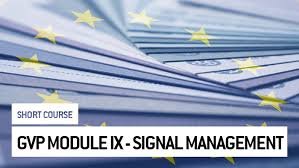Guideline on good pharmacovigilance practices (GVP): Module IX – Signal management

✅ GVP Module IX – Signal Management
📘 Purpose
GVP Module IX provides comprehensive guidance for Marketing Authorisation Holders (MAHs) and regulatory authorities on how to perform signal management, which is a core part of pharmacovigilance. The goal is to ensure timely detection, assessment, and action on potential risks associated with medicinal products.
🔹 What is a Signal?
A signal is:
“Information arising from one or multiple sources (e.g., ICSRs, studies, literature) that suggests a new potential causal association, or a new aspect of a known association, between a medicine and an adverse event.”
🔹 Objectives of Signal Management
-
Identify new or changing risks associated with medicinal products.
-
Evaluate and prioritize signals based on public health impact.
-
Ensure appropriate regulatory action is taken, if needed.
-
Maintain an up-to-date safety profile of the product.
🔹 Steps in Signal Management Process
1. Signal Detection
-
Sources:
-
Spontaneous reports (ICSRs)
-
Scientific literature
-
Observational studies
-
Clinical trials
-
Social media (if monitored)
-
-
Tools:
-
EudraVigilance Data Analysis System (EVDAS)
-
Statistical algorithms (e.g., disproportionality analysis)
-
2. Signal Validation
-
Check if the information is:
-
New
-
Valid and supported by data
-
Relevant to the product
-
-
Determine if it justifies further assessment.
3. Signal Confirmation
-
Regulatory authorities (e.g., PRAC) or MAHs may confirm a signal based on validation.
-
Confirmed signals are communicated for assessment.
4. Signal Analysis and Prioritization
-
Analyze the signal’s:
-
Strength of evidence
-
Clinical relevance
-
Public health impact
-
-
Prioritise based on urgency and seriousness.
5. Signal Assessment
-
Conduct detailed medical and scientific evaluation.
-
Assess:
-
Causality
-
Frequency
-
Risk factors
-
-
Identify the need for additional data or regulatory action.
6. Recommendation for Action
-
If risk is confirmed, recommend:
-
Product information changes (SmPC, PIL)
-
RMP updates
-
Further studies
-
Market suspension (in rare cases)
-
7. Communication
-
MAHs and authorities must communicate outcomes of signal assessments:
-
To healthcare professionals
-
Through regulatory communications (e.g., DHPCs)
-
Via public databases
-
🔹 Roles and Responsibilities
-
MAHs: Ongoing signal detection, documentation, and submission of relevant findings.
-
PRAC (EU): Oversees central signal detection and confirms/prioritizes signals.
-
EMA/NCA: Collaborate with PRAC in signal assessment and decision-making.
🔹 Documentation & Quality
-
Maintain detailed records of each step.
-
Ensure SOPs, trained staff, and audit trails are in place.
🔹 Key Tools
-
EudraVigilance & EVDAS
-
EU Reference Dates (EURD) list
-
Literature monitoring
-
Risk Management Plans (RMPs)
📌 Conclusion
Signal management is a systematic, proactive process essential to maintaining drug safety post-authorisation. GVP Module IX ensures that all safety signals are detected, validated, assessed, and acted upon in a timely and transparent manner to protect public health.
🎓 Discover one of the best Pharmaceutical Pharmacovigilance course available — click below to explore the course that’s shaping future Pharmacovigilance skills.

